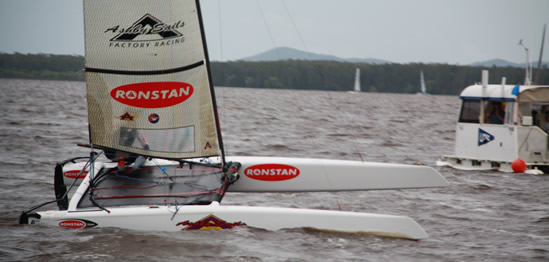http://www.americascup.com/2010/12/work ... ead-in-nz/
Euhhh??? Les 3 dernières photos, c'est des éléments de l'aile?
R
On en as parlé mais t as tout oubliégattaca a écrit :Bon mon amour propre va en prendre un coup, mais je fais mon mea culpa:
J'avais pas reflechi que sur les photos d'étraves que je voyais, elles étaient à l'envers
Il y a quand même un point sur lequel le design est un peu à l'ancienne et on en a déja parlé ailleurs, c'est la largeur des bateaux.
C'est bizarre, dès que je vois un bateau assemblé, je perds tout esprit critique et n'ai envie que d'une chose... Naviguer!
Si c'est un modèle réduit de celle d'Oracle ?Les mât seront ils inclinables? ça influe sur la stabilité aussi, non?
Et moins ils sont puissants et plus il faut jouer en finesse.
New AC45...The one-design wingsail consists of two elements. It is a scaled down concept of the 223-foot tall wing that powered BMW ORACLE Racing’s trimaran USA to victory in the 33rd America’s Cup Match.
The wing will have simple, manual control systems. There will be two headsail options, a gennaker and jib, but no Code 0 headsail.
“The AC45 is small enough that it doesn’t need hydraulics. The loads drop quickly when you get down to a boat of this size,” said Ian Burns, design team coordinator for BMW ORACLE Racing. “There aren’t even grinder pedestals. The winches will be powered by top-handle grinding.”
Keeping with the simplification theme, the AC45 will have straight daggerboards. No articulation beyond raising and lowering is permitted.
Crews are likely to number five at an average weight of 85 kilograms (approximately 187 pounds) to fit the AC45’s future role in the Youth America’s Cup.


bogs.marinij* How unique do you think the AC45 is compared to other racing cats of around the same size already out there?
Jim Antrim: What really makes it most unique is the wingsail. They've been around but not real popular, for many years really. It's always been just one or two here and there up until now. Wings are very powerful and efficient sails so that would be the primary thing - other than that, they're just pretty much a light narrow racing catamaran sort of similar to the boats called the Formula 40s which became the Pro 40 back in the late 80s. Then there's the 1-design circuit going on now, the Extreme 40s. The AC45 is similar to those boats really, other than the wing.
* The AC45 seems like its pretty "stripped down", the focus being on simplicity. How do you think this theme will play out on the water both with regard to performance and "spectacle" factor?
Jim Antrim: I think its actually good because it will force the sailors to focus on tactics and speed and keeping the boats controlled. There are going to be plenty going crazy fast as it is, whereas if you did more extreme things like foil borne boats you're going to have more crashes. That's kind of fun to watch but if the boats are out of control too often it loses the interest of the audience - one guy is three miles ahead because the other guy crashed. So I do think simplicity is a good idea.
* What's your thought on how a scaled down version of BORs famous wingsail will transfer to these smaller boats?
Jim Antrim: The performance of the wingsail can be incredibly good. The challenge has always been engineering them to make them light enough and it's become quite expensive to do that. If you capsize the boat they're usually a wreck so that's an expensive proposition so the idea of keeping them light enough so that they're not flinging a lot of weight around in the air. Being an America's Cup class I guess we don't care much about the cost of building them but the fact that they are being built in that format will promote ideas and make them more popular and easier to build, probably, in the future.
The huge advantage of a wing is that it has a round, broad leading edge so it has a variable tack angle where with a flat sail you essentially have to have exactly very limited angle at the entry of the sail to keep it from either luffing or stalling and also with a rigid wing you can flatten them out without making it totally luff so you can go to a really low drive low drag situation as the wind builds up. So they have quite a range of operation and just a better luff to drag ratio.
* Are there other elements that you would have liked to have seen in this boat, anything that you may have done differently to enhance performance/excitement factor?
Jim Antrim: We don't know too much about the boats yet other than what they look like - we don't know exactly how heavy they are or how tall the rig is but one of the interesting problems you have with catamarans is keeping the boat stable fore and aft as it is sideways which limits the beam of the boat. It looks to me like they've got a boat with very low buouyancy in the bow of this thing by the looks of it, a somewhat faddish reverse rig stem on them and very low freeboard so there's not a lot of buoyancy up there to keep the boat from pitch-poling or burying the bow but on the other hand they look like the beam of the boat is rather narrow so I think they may have a good balance that way. I do think some foil assist may be interesting but it does create complexity and expense and maybe distracts from the idea that we were just talking about - that simplicity seems to be a good thing for this concept.